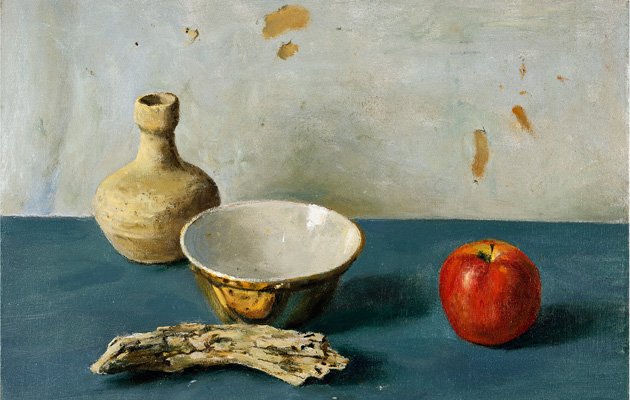Exhibition review: Eric Rimmington still-lifes in Henley-on-Thames
This new exhibition in Henley-on-Thames admires the still-life paintings of Eric Rimmington.


Over the centuries, there have been many sorts of still-life: the groaning boards of the Dutch and Flemish Golden Age with their flipside in the skulls and candles of vanitas painting; the earthenware crocks and drying vegetables of Spanish bodegones; the accidental clutter of kitchen tables by Jean-Baptiste-Siméon Chardin; and the Campbell’s soup tins and Brillo boxes of Andy Warhol, more about the packaging than the contents.
Eric Rimmington’s still-lifes are none of the above. Although they also feature crocks, drying vegetables and colourfully labelled tins and packets, there is nothing accidental about them the objects are there for one purpose and one purpose only. ‘It’s not like a kitchen with onions ready to cook,’ says the artist firmly. ‘They’re not for cooking, they’re for painting.’
Composition is half the battle for Mr Rimmington. He’ll spend hours auditioning objects for a painting and allotting them spots on his studio table, because his work is as much about abstract qualities of colour, form and space as it is about seductive illusionism—although that matters, too. He’s as susceptible as the rest of us to the magic of ‘making realistic, touchable, tangible things’, or what he calls ‘the awful tension between the knock-on solidity of things and the space that’s revealed behind them’.
In the 1960s, he was an abstract artist, making constructions out of driftwood and debris picked up on the Malaga coast where he spent his summers. Like the rest of his generation, he was in thrall to Modernist abstraction and embarrassed at the idea of Realism, but a teaching job in America in the mid 1970s rel-eased him from the prescriptiveness of the English art world. ‘I was freed from smarty-pants stuff,’ is how he puts it. ‘I came back and decided to paint what I saw.’
Returning to a tiny flat in Worcester, he started with tins of tomatoes on a mantelshelf and has painted things within his hand’s grasp ever since. It’s a funny assortment of objects, the flotsam of years stored in cardboard boxes and crammed into his small first-floor studio in London’s Stoke Newington. There are odd little bits of china from his late mother-in-law’s garage, exotic foodstuffs from Dalston’s Ridley Road Market, driftwood and pebbles from Selsey beach in West Sussex and a dried leaf from the street outside—his beachcombing has never been confined to beaches.
The provenance of each object is important. In a way, they are souvenirs without the sentiment, mundane objects that, for Mr Rimmington, ‘carry within them the resonances of the world’, discarded fragments of human experience reconfigured into things of beauty, like patches of worn-out clothes pieced into a quilt.
Exquisite houses, the beauty of Nature, and how to get the most from your life, straight to your inbox.
It’s obvious from looking at these pictures that there’s more to them than meets the eye. But what? We’re left to play with the pieces and puzzle it out. Some logical connections suggest themselves, as between the box of Ship matches with its image of a clipper and the Chinese ceramic pot behind, but the meanings aren’t always clear to the artist himself.
The choice might be dictated by shape or colour: a red enamel bowl, a yellow bar of French laundry soap, a blue-painted stone or a frayed coil of emerald binder twine provide Mr Rimmington with a ready-made palette that saves him having to make the colours up. Some objects carry more significance than others, like the red brick worn pebble-smooth by the sea, a relic of a fallen house on England’s crumbling south coast. ‘That’s the sea for you,’ he comments philosophically.
There’s the occasional flash of showmanship to remind us of the ‘smarty-pants stuff’ of which this virtuoso painter is capable: the distorted reflection of a piece of driftwood in a lustre-glazed bowl, or the translucent shadow of a jar of stand oil thrown onto a copy of a Poussin drawing.
Drawings and paintings sometimes form a background to his compositions, but, usually, it’s the bare walls of his studio: the east wall with its scuffed white wallpaper, or the west wall with the paper peeled back to the plaster, a moody surface across which salt stains drift like clouds. Within these walls, the artist, now 88 ‘a batty old git doing a very unstill-life’, as he self-deprecatingly describes himself—is still performing his peculiar magic. There never was a still-life painter quite like him and I doubt if there ever will be again.
‘Eric Rimmington: New Still-life Paintings’ is at Bohun Gallery, 15, Reading Road, Henley-on-Thames, Oxfordshire, from November 1 to 23 (www.bohungallery.co.uk; 01491 576228)
Country Life is unlike any other magazine: the only glossy weekly on the newsstand and the only magazine that has been guest-edited by His Majesty The King not once, but twice. It is a celebration of modern rural life and all its diverse joys and pleasures — that was first published in Queen Victoria's Diamond Jubilee year. Our eclectic mixture of witty and informative content — from the most up-to-date property news and commentary and a coveted glimpse inside some of the UK's best houses and gardens, to gardening, the arts and interior design, written by experts in their field — still cannot be found in print or online, anywhere else.
